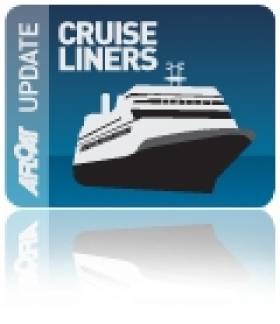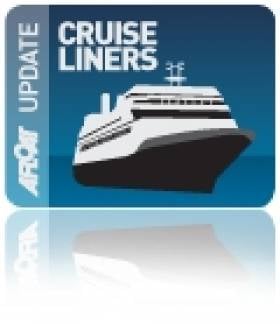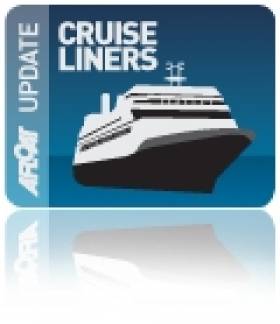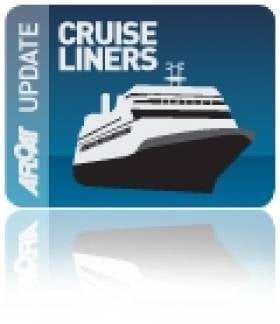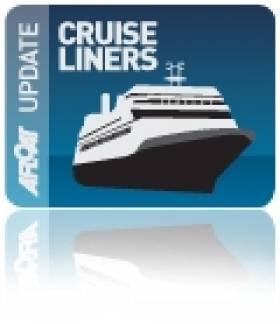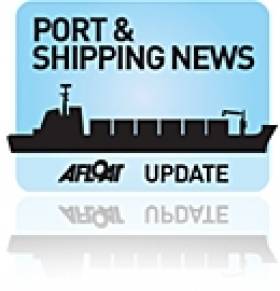Displaying items by tag: Cruiseliners
From Falmouth to the Fjords
#CRUISE LINERS – Dublin Port's first cruise caller for this season will be Arion which today sets sail from Falmouth on an eleven night / twelve day cruise to Scotland and Norwegian fjords. The 5,888 gross tonnes cruiseship built in 1965 is to berth in the capital at Ocean Pier, writes Jehan Ashmore.
The veteran vessel which has sleek traditional lines can carry over 300 passengers and she is operated by Classic International Cruises. Her visit will be one of around 90 cruise calls scheduled to Dublin Port during this year's season which stretches to early October. The majority of these calls will be in the summer and where several ships will be making repeat port of calls.
With so many callers to Dublin Port, this brings a greater variety of vessels as evident between the Arion and Princess Cruises considerably larger Grand Princess which is due next week. The giant vessel weighs over 109,000 gross tonnes and has a capacity for over 4,000 passenger and crew.
The Portuguese flagged Arion is also set to open the season to Galway, as previously reported she is to make an anchorage call off the mid-west harbour next month.
Meanwhile following all the recent focus centred in Cobh, Cruise & Maritime Voyages Marco Polo is expected to arrive this afternoon by berthing at the town's dedicated cruiseship quayside.
Cruise Liners Line-Up for Foyle
#CRUISE LINERS-Aside the main ports where most cruise ships visit while touring this island, Londonderry would be a less frequent destination, as such vessels only began visiting the north-west port since 1995, writes Jehan Ashmore.
Some of the leading operators though have called over the years called to the port, they are: Crystal Cruises, Cunard Line, Residensea, Seabourn and Silverseas.
This year's line-up will see eight scheduled calls starting in May with the 446 passenger Quest for Adventure (for more click HERE) built in 1981 and operated by Saga Cruises. A younger near-sister Astor built in 1987 is also due to call in August.
Below is a list of the cruise callers and dates.
Quest for Adventure 9 May
Marco Polo 14 July
Prinsendam 16 July
Astor 11 August
Clipper Odyssey 18 August
Princess Daphne 30 August
Albatross 12 September
Ocean Countess 15 September
The vessels will use various berths dependent upon size within the port which is run by the Londonderry Port and Harbour Commissioners. The facilities are at the city quays, Lisahally or require anchorage off Greencastle in Lough Foyle.
Cruiseship Designed for Great Lakes Calls to Dublin Port
#CRUISELINERS– A vessel at first glanced resembling that of a Mississippi riverboat in reality an ocean-going cruiseship designed also to serve on the US Great Lakes, docked in Dublin Port today, reports Jehan Ashmore.
The 91m Sea Discoverer (4,954grt) berthed at the port's Ocean Pier and without any passengers on board, as the 294 capacity vessel was making an en-route repositioning voyage from the UK to mainland Europe.
Her brief port of call was to carry out a crew-change, following an overnight passage from Barrow-in-Furness in Cumbria, where she had completed a near six-month charter.
Her owners International Shipping Partners (ISP) chartered the luxuriously appointed vessel (click PHOTOS) to Siemens Wind UK for use as an accommodation quarters for personnel working at a wind-turbine installation project.
Sea Discoverer had made a previous call to Dublin Port during August, where the vessel loaded stores and bunkers prior to completing the voyage to Barrow-in-Furness, following a trans-Atlantic voyage.
She is classified by Lloyd's Register (100 A1 LMC) and built to SOLAS (Safety at Life at Sea) lifesaving according to 46CFR and SOLAS 2000.
The Bahamas-flagged vessel has a straight-stemmed bow and a cruiser-stern which are most unusual for a ship only completed in 2001 and to be seen in Irish waters.
Such features reflect her original 'intended' purpose as she was launched as Cape Cod Light along with an earlier sister Cape May Light at the Atlantic Marine shipyard, Jacksonville in Florida.
They were commissioned for American Classic Voyages who planned to operate the sisters in the Great Lakes during the summer months and along the US East coast during Spring and the 'Fall' and the Mexican Gulf as far as Belize for the winter.
American Classic Voyages went bankrupt right after the introduction of Cape May Light (now Sea Voyager) also owned by ISP, which manages a diverse fleet on the charter market globally.
The bankruptcy was due to the aftermath of the September 11 terrorist attacks and the unfinished second sister Cape Cod Light (Sea Discoverer) was repossessed by the shipyard and eventually sold to ISP.
Incidentally American Classic Voyages had acquired the Delta Queen Steamboat Company, operators of the famous Mississippi riverboat Delta Queen, hence the design influence in the Cape May Light and her sister respectively. For photo of the 'Cape's seen moored together click HERE.
According to ISP they are negotiating another charter for Sea Discoverer, also for accommodation purposes in Northern Europe, and they hope to have the contract completed next week.
She sailed out of Dublin Bay late this afternoon, passing The Muglins off Dalkey Island. Her brief call to Dublin Port certainly made for a most usual call by a cruiseship whose role was to operate in the Lakes and on the High Seas.
- Cruiseliners
- Dublin Port
- Cape May Light
- Cape Cod Light
- Mississippi riverboats
- Delta Queen
- Siemens Wind UK
- BarrowinFurness
- Sea Discoverer
- Sea Voyager
- US Great Lakes
- Gulf of Mexico
- US East Coast Ports
- Belize
- Atlantic Marine Shipyard, Jacksonville
- American Classic Voyages
- The Muglins, Dalkey Island
- Dublin Bay
Belfast to Showcase Holiday World
#HOLIDAY WORLD SHOW -The Belfast Telegraph Holiday World Show will be officially opened by actress and comedian Crissy Rock of I'm a Celebrity... Get Me Out of Here' fame, where she is to 'check in' at the city's King's Hall, this Friday.
The three day show (20th -22nd January) which ends on the Sunday, is Northern Ireland's biggest annual public showcase of travel, tourism and hospitality will offer an array of holiday destinations. Around 30,000 visitors are expected to the show during the weekend.
It will also be the show's 20th anniversary, commenting on the milestone, organiser Edmund Hourican said: "In 2012 we'll be celebrating 20 years of Holiday World Belfast. While much has changed during that time, the event still provides would-be travellers with a hassle-free opportunity to find out about and compare destinations, airlines, travel agencies - and their prices.
"Today's savvy travellers understand that 'best value' doesn't necessarily mean 'cheapest'. Rather, they are looking to find the products and services that best match their requirements. While visitors to Holiday World Belfast are typically prepared to invest in holidays – often heavily - they do want reassurance that they are making the right choices and getting the best deal. The fact that Holiday World is packed with special offers and discounts is a welcome extra bonus!"
Following the popularity of last year's launch by Oasis Travel of the Cruise Pavilion, this part of the show is also to return in 2012, bringing the biggest names in cruising and will include the successful series of cruise lectures suited to both the experienced 'cruiser' and those completely new to this style of holiday.
In addition this year will feature an all new event-within-an-event Over 55s Holiday Show, adding an important new focus to Holiday World Belfast. To read more details of the show, exhibitors including ferry and cruise operators, and for opening times and admission prices click HERE.
Following the Belfast show, it will be the turn of Dublin to host the Holiday World Show in association with The Sunday Times which opens on the following weekend (Friday 27th-Sunday 29th January) in the RDS Simmonscourt Pavillon, Ballsbridge.
Like the Belfast show there will be an Over 55's Holiday Show plus the Caravan & Motorhome Show. For further details of the show they can be viewed HERE.
- Holiday World Show
- Ferry operators
- Cruise operators
- The Sunday Times
- Belfast Telegraph Holoiday World Show
- Kings Hall Belfast
- Oasis Travel
- Cruise Pavillon
- Cruiseliners
- RDS Dublin
- RDS Simmonscourt
- Ferry news
- Crissy Rock
- I'm a CelebrityGet me out of Here
- Irish travel firms
- Irish tourism
- Northern Ireland tourism
Cruiseships Great and Small Lineup for Dublin 2012
#CRUISE LINERS- Around 85 cruiseships are scheduled to call to Dublin Port in 2012, which compares closely to the same number of calls for this year's season, writes Jehan Ashmore.
First to start the season will be Grand Princess, which has the accolade of being the inaugural cruiseship to enter the port with a tonnage surpassing the 100,000 gross tonnes. The milestone was marked by the Princess Cruises call in 2004.
As usual with that number of cruise-callers, the variety of vessels will range from the small to the very large. A prime example is the diminutive expedition cruiseship Quest (1,180 tonnes) and at just under 50-metres long has just over the same number in passenger capacity.
In complete contrast to the ice-strenghtened Quest is the giant Caribbean Princess, a larger sister of Grand Princess, can accommodate over 3,000 passengers and she is make several calls.
Noble Caledonia which has been operating Quest (PHOTO) on successful seasons in Scotland, is to embark on itineraries next season to Ireland, England and Wales for the first time. Her half-sister Ocean Nova has called to Dublin on previous occasions.
For only the second time, Queen Elizabeth is due return to the capital (for report click HERE) in late Summer and in the same week, Hebridean Princess is also scheduled to call. The later vessel in recent years was chartered to Queen Elizabeth II, for a cruise off the Scottish Isles. To read more on the small ship's visit to the port earlier this year click HERE.
Cruise-Goers Head for the Galway Races
The vessel first visited Galway in 2009 but this call will be her last year operating under the Spirit of Adventure cruise banner. The company are to replace the vessel next season with the Saga Pearl II which will be transferred from the parent company Saga Cruises and renamed Quest for Adventure.
Prior to the Spirit of Adventurer's call, the 226 passenger Le Diamant arrived from St. Malo last Friday. She became the first vessel to make a call to the 'City of the Tribes' on behalf of her French operators, Cie de Ponant. Her passengers were taken on tours of the city, Connemara and the Aillwee Caves in neighbouring Co. Clare. The vessel is due to return early next month.
With three cruise-calls this year the port is set to increase this figure to 7 in 2012 arising from the ports campaign over the last two years. Paul Carey, Chairman of the Harbour Company, said "We are beginning to see the fruits of this campaign and look forward to growing Galway's association with the return of the majestic passenger liners to Galway".
"The passenger liner The World has been confirmed for a two-day visit in August 2013 which is a great endorsement of Galway as a cruise destination".
The call by the world's first ocean-going luxury resort vessel will also be another first for Galway. Operators of the 43,524gt vessel, Residences at Sea have made previous Irish ports of call to include Dublin, for more on her to the capital last August click HERE.
- Dublin Port
- Galway Bay
- Foynes
- Shannon Estuary
- The World
- Cruiseships
- Ports and Shipping News
- city of the tribes
- Galway Harbour
- Galway Harbour News
- Mutton Island
- Le Diamant
- Cruiseliners
- Saga Cruises
- Spirit of Adventure Cruises
- Spirit of Adventure
- Galway Harbour and Bay news
- Galway Port
- Port of Galway Company
- Ponant Cruises
- Galway Races
- The Galway Races Ballybrit
- Ballybrit Race Course
- Port of Foynes
- Saga Pearl II
- Quest for Adventure
- Shannon Estuary and port news
- The World cruise liner
- Residences at Sea
- The World Residences at Sea
- Irish cruise ports of call
- Irish cruise calls
- Cruiseships to Ireland
- Cruise Companies visiting Ireland
- West of Ireland cruise callers
Cruiseship Calls to Dublin Includes Ship-to-Ship Refuelling
Some six hours previously Swan Hellenic's sleek Minerva (1996/12,500grt) picked up a pilot off Dalkey after sailing overnight from Portsmouth. She was followed astern by Saga Cruises Saga Ruby (1973/24,292grt) from Dover and likewise she too picked up a pilot close to the South Burford bouy. Incidentally Minerva had operated for Saga Cruises as their Saga Pearl but in recent years she has returned to her original name.
The classic lines of Saga Ruby are attributed to her combined ocean liner/cruiseship design when launched Vistafjord in 1973. The vessel was built by Swan Hunter Shipbuilders for Norwegian America Line. A decade later she was sold to Cunard Line who retained her original name until 1999 when she became the third Caronia. To read more about this former 'Cunarder' click HERE and how her interior looks now click HERE.
Dawn Princess departed Dublin this mid-afternoon bound for Cobh. Minerva is to due to leave around midnight while Saga Ruby remains overnight, in fact her call is particularly leisurely as she does set sail from the capital until tea-time tomorrow.
- Dublin Port
- Cobh
- Cruise Liners
- bunkers
- dalkey
- Princess Cruises
- Cobh Cruise Terminal
- Cruiseships
- Port of Dublin
- Ports and Shipping News
- Ocean Pier
- Cunard Line
- Cruiseliners
- Saga Cruises
- Saga Ruby
- Caronia
- Cruise Liners news
- Cruise ships
- Swan Hellenic Cruises
- Dawn Princess
- Minerva
- Refueling
- Dublin Cruiseships
- Dublin cruisecalls
- Saga Pearl
- Coastal tanker
- South Burford bouy
- Cunarder
Loop Head: A Guiding Light for Foynes-Bound Cruise Calls
Her arrival will be followed by P&O Cruises latest addition Adonia on Saturday. With 710 berths the 30,000 tonnes vessel is the smallest of the seven-strong fleet which can accommodate between 1,800 and up to 3,100 passengers as in the case of the Azura. The 115,000 tonnes vessel departed Dublin Port this evening. Her first call to the port was last year (click HERE) and she is the largest cruise ship to call to the capital.
On Tuesday of next week the 9,000 tonnes Spirit of Adventure (cruises) marks the third cruise caller to Foynes. The port is along with five other terminals located throughout the country's largest estuary are operated by the Shannon Foynes Port Company (SFPC).
Incidentally Spirit of Adventure and Azura where two of another trio of cruise ships that visited the Port of Cork on Monday, with Holland America Line's 59,000 tonnes Rotterdam forming the third vessel. This was the first occasion that Cork has handled this number of cruise ships on a single day, bringing 7,000 passengers which set a new record for the port.
- Shannon Estuary
- Shannon Foynes Port Company
- P&O Cruises
- Loop Head
- Cruiseships
- lighthouses
- Dublin Port news
- Holland America Line
- Port of Cork News
- Le Diamant
- Cruiseliners
- Spirit of Adventure
- Shannon Estuary news
- Loop Head Lighthouse visitor centre
- Azura cruise ship
- Spirit of Adventure cruiseship
- Adonia cruiseship
- Rotterdam cruiseship
- Loop Head Lighthouse
- Shannon Estuary and River
- Shannon Estuary and River news
- Lighthouse news
- Irish cruise calls
- Irish ports of call
- Foynes Port
Floating City Hotel to Mark Start of Islands Cruise
Passengers embarking in Dublin Port for a cruise next month will firstly spend their first night onboard while docked in the capital, writes Jehan Ashmore.
The classic cruiseship Saga Ruby will welcome her passengers and after checking in they can explore the 4-star rated vessel followed by dinner, marking the first evening of an eight-night cruise of the Faroe, Orkney & Outer Hebridean Islands.
On the following day passengers can remain onboard and enjoy the facilities or take an optional tour of Dublin or Wicklow prior to returning to the cruiseship for the evening departure on 24 July.
Prices start from €1,159pp in a twin inside cabin, for more information on other cabin categories and the cruise from John Galligan Travel click here.
Saga Ruby is one of the last traditionally built cruiseships, featuring spacious wooden decks in particularly on the tiered decks overlooking her cruiser stern. The 24,492 tonnes vessel joined Saga Cruises in 2005 after a $17m refit and was at one stage was the Caronia of Cunard Line, but she started her career as Vistafjord for Norwegian America Line as a combined cruise-liner /cruise-ship when built in 1973. To read more about the classic ship click here.
She can take over 600 passengers and is currently operated by the Saga Cruises which caters primarily for the UK over-50's market noting passengers can be accompanied by adults over 40.
US Training-Ship Heads for Cork
For five-days the US training-ship State of Maine will make Cork Harbour her port of call, when the 16,000 tonnes vessel docks this evening, writes Jehan Ashmore.
The 500-foot long ship is on a 55-day training cruise that started late last month from her homeport of Castine Harbour in Maine. Since then the Maine Maritime Academy's training-ship has visited Norfolk, Virginia before crossing the Atlantic to include calls to Valetta, Malta and the vessel's most recent port of call was Civitavecchia in Italy.
Onboard the former oceanographic vessel that served in the US Navy as the USNS Tanner, there are students, officers and crew. The Maine Maritime Academy purchased the vessel in 1997 and she was converted to accommodate the training needs of the college.
The academy was founded in 1941 and enrolls more than 900 students from 35 states and from several foreign countries. Students in the college are awarded A.S., B.S., and M.S. degrees in 15 fields of study.
State of Maine is to berth at the Cobh Cruise Terminal, the facility which normally caters for cruiseships is to be followed by another training-ship the 17,000 tonnes Empire State on 22 June.


























